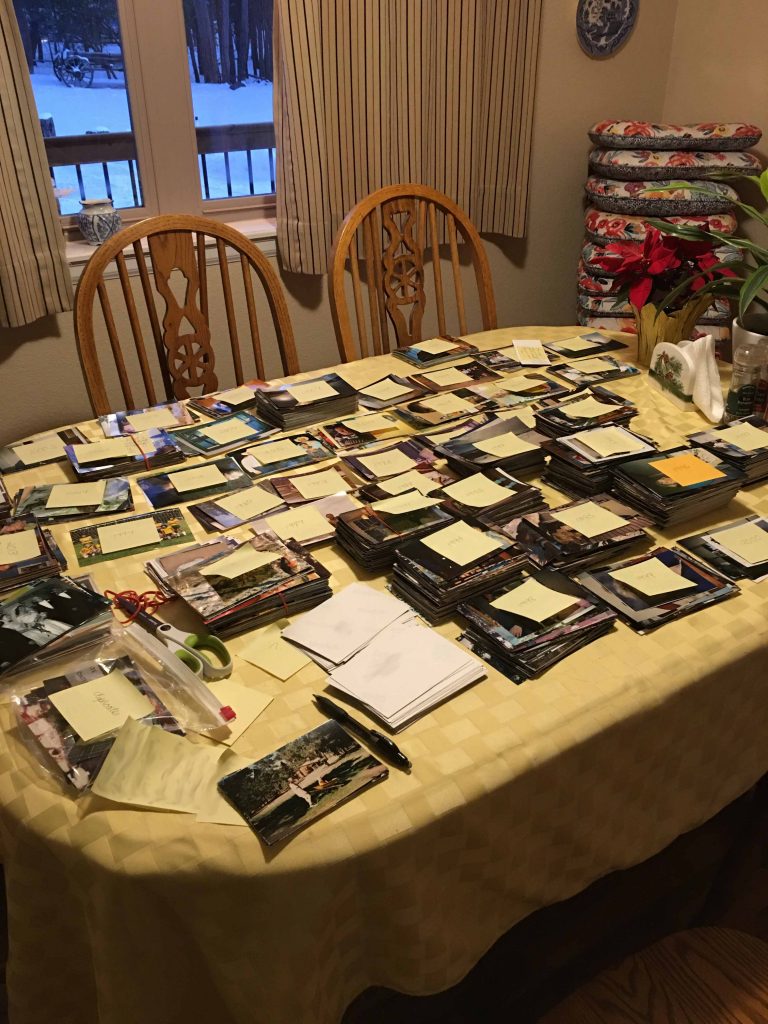
This month I tackled a project that’s been put off for decades. Yes, decades. Notice the picture of our dining table covered in piles of photographs. They’ve been stored in a big cardboard box which I moved from upstate NY to Colorado in the 90’s, then saved from the wildfire in 2013. They’ve been sitting in a closet ever since, jumbled together in no particular order. Most of them lack notes on the back to show the year taken and names of those wonderful people.
Recently, I decided to organize them. It’s been time consuming and a huge memory test. But the effort has been worth it.
That table is chock full of lives, mine and those who have been closest — husband, parents, children, siblings, in-laws and friends. Some are gone now due to death, divorce or relationships that ran their course.
I told my daughter, “You’ll thank me for this one of these days!” She just laughed.
Our photos won’t be shown on social media. And they won’t just be stored on a password protected phone. They’ll be in hefty albums, accessible to friends and family regardless of anyone’s techno-savvy skills. Not everyone wants to sort through hundreds of thumbnails and swipe across a screen to view the latest images.
The Need for Multiple Communication Methods
We can’t assume everyone will use an iPhone, computer or instagram to share memories or messages, today and in the future. I’m sure you know people who rely on email but don’t text. There are those who only text. Some prefer to chat through facebook and believe it or not, some still write letters.
If we’re serious about getting our messages out, shouldn’t we consider using multiple communication methods?
When I worked in communications for a city government, it was our job to publicize the Mayor’s town hall meetings. We used every social media platform and sent an internal email. Yet there was still a young tech-savvy manager who said he hadn’t seen the message. It wasn’t until the day before the event he found a flyer taped to the inside of the elevator! Definitely low-tech, but it worked.
The Drawbacks of Single Communication Methods
Some sports and entertainment venues now rely on digital tickets. Customers must navigate to a website, set up an account, then download an app which takes you to a QR code that serves as a digital ticket. Even as skilled as many of us are with technology, it’s been a pain to go through the process. By relying on this method, venues exclude a segment of their audience who won’t bother with the contortions necessary to attend their event.
In most states, schools are not required to teach cursive handwriting. The justification: computer tablets are more efficient and increasingly used for studies and homework. Educators believe the time required to teach cursive could be better utilized. More than one study has found that too much screen time can be harmful for children and cursive is still necessary in the workplace and society. Again, the assumption that one form of communication is all that’s needed is seriously flawed. We don’t need to hamstring our youth by limiting their ability to communicate with only digital tools. Handwriting has been proven to have significant benefits because it helps develop other skills.
https://www.hopkinsallchildrens.org/ACH-News/General-News/Screen-Time-Side-Effects-in-Kids-and-Teens
https://www.success.com/the-benefits-of-handwriting/
The irony of me writing this article on my computer, then sending it out via email is not lost on me.
Great Movie:
The Grand Seduction. “A small fishing village must attract and retain a doctor to secure a lucrative business contract to ensure jobs for all. When big city doctor Paul Lewis lands in their lap for a trial residence, the townsfolk rally together to charm him into staying.” (imdb.com) We loved this movie! It’s laugh out loud funny, especially the final scene.
Great Quotes:
“I never went to a John Wayne movie to find a philosophy to live by or to absorb a profound message. I went for the simple pleasure of spending a couple of hours seeing the bad guys lose.” —Mike Royko
Write hard and clear about what hurts. —Ernest Hemingway
“You cannot do a kindness too soon, for you never know how soon it will be too late.” —Ralph Waldo Emerson
“You are only young once. After that you have to think up some other excuse.” —Billy Arthur